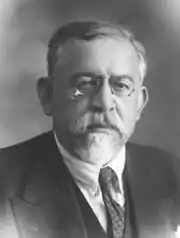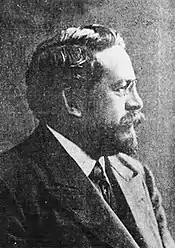Yusuf Akçura
Yusuf Akçura (Tatar: Йосыф Хәсән улы Акчура, romanized: Yosıf Xäsän uğlı Aqçura; Russian: Юсуф Хасанович Акчурин, romanized: Jusuf Hasanovič Akčurin; 2 December 1876 – 11 March 1935) was a prominent Turkish politician, writer and ideologist of ethnic Tatar origin. He developed into a prominent ideologue and advocate of Pan-Turkism during the early republican period, whose writings became widely read and who became one of the leading university professors in Istanbul.
Yusuf Akçura | |
|---|---|
 | |
| President of Turkish Historical Society | |
| In office 8 April 1932 – 11 March 1935 | |
| Preceded by | Tevfik Bıyıklıoğlu |
| Succeeded by | Hasan Cemil Çambel |
| Personal details | |
| Born | 2 December 1876 Simbirsk, Russian Empire (now Ulyanovsk, Russia) |
| Died | 11 March 1935 (aged 58) Istanbul, Turkey |
Biography

He was born in Simbirsk, Russian Empire to a Tatar family[1] and lived there until he and his mother emigrated to the Ottoman Empire when he was seven. He received primary and secondary education in Constantinople[1] and entered the Harbiye Mektebi (Military College) in 1895. He took up a post in the Erkan-i Harbiye (General Staff Course), a prestigious training programme for the Ottoman military.[2] But in 1896 he was accused of belonging to the Young Turk movement and was exiled to Trablusgarb in Fezzan, Ottoman Libya.[3]
He escaped exile in 1899 and made his way to Paris where he began to emerge as a staunch advocate of Turkish nationalism and Pan-Turkism. There he contributed to Meşveret, a periodical published by the exiled members of the Committee of Union and Progress.[4] He returned to Russia in 1903, settled in Zöyebașı beside Simbirsk[5] and began to write extensively on the topic.[3] He garnered most attention for his 1904 work Üç Tarz-ı Siyaset (Three Policies), which was originally printed in the Cairo-based magazine Türk.[6] The work encouraged the formation of an Ottoman Nation with a citizenship based on Islam and compared such a nation with Germany, Switzerland and France which according to him had also emerged from different races.[1] Further on, he demanded to abandon the multi-ethnic concept of the Ottoman Empire and to focus on the assimilation of the non-Turks.[1] He was one of the co-founders of the Ittifaq al-Muslimin, a Muslim party in Russia.[7] In 1908 he returned to Istanbul[8] where his ideas began to gain more interest after the Young Turk Revolution and the proclamation of the Second Constitutional Era.[3] In 1911 he founded the Türk Yurdu Association together with Ahmet Ağaoğlu, Ali Hüseynzade and others.[9] In November 1911 The association began to publish a magazine bearing its name, Türk Yurdu, which sought to become the intellectual force behind Turkish nationalism.[10] In June 1911, he became a leading force within the Turkish Hearths, acting as their Vice-President.[11]
In 1915 he founded again with Ahmet Ağaoğlu and Ali Hüseynzade the Turco-Tatar Committee (TTC) in Istanbul which had the aim to defend the rights of the Turco-Tatar Muslims in Russia.[12] In June 1916 the TTC sent a delegation to the Conference of Nationalities, but it could not present a united resolution. Every delegate had to represent his nation. Akçura therefore spoke for the Tatars and demanded the same civil, politic and religious rights as the Russian Orthodox and the right to teach in their native tongue. In July 1916 he visited Zurich and made contact with Vladimir Lenin. He wanted to know what the fate of the Turkic peoples would await from the leader of the revolutionaries.[13] In Summer 1917 he was given the task to negotiate the liberation of the Ottoman prisoners in Russia by the Ottoman Red Crescent. He therefore first travelled to Denmark, Sweden and stayed about one year in Russia.[14]
After having accomplished his mission for the Ottoman Red Crescent, he returned to Turkey and joined the newly founded party Milli Türk Fırkası in October 1919.[15] Differing from the regime somewhat, he defined the Turkish identity in purely ethnic terms and came to look outside the borders of the country for a kinship with other Turkic peoples. He also called for creation of a national economy and a move away from Islamic values (an area in which he clashed with Ziya Gökalp, as Akçura wanted a secular Turkey, fearing that Pan-Islamism would hinder nationalist development), meaning that he was largely sympathetic to Kemal Atatürk. In 1923 he was elected MP for Istanbul, which he stayed until 1934, when he was elected MP for Kars.[16] In 1932 he became president of the Turkish Historical Society.[17]
He died in Istanbul in 1935. He was laid to rest at the Edirnekapı Martyr's Cemetery in Istanbul.[18]
See also
References
- Poulton, Hugh (1997). Top Hat, Grey Wolf, and Crescent: Turkish Nationalism and the Turkish Republic. C. Hurst & Co. pp. 72–75. ISBN 0-81476648-X.
- Thomas, David. "Uc Tarz-i Siyaset (Three policies), Yusuf Akcura (1876-1935)". Archived from the original on 22 February 2005. Retrieved 28 September 2019.
- Akçura, Yusuf (2013), "Three types of policy", Modernism: The Creation of Nation-States : Discourses of Collective Identity in Central and Southeast Europe 1770–1945: Texts and Commentaries, volume III/1, Discourses of Collective Identity in Central and Southeast Europe 1770–1945, Central European University Press, pp. 218–226, ISBN 9786155211935
- Hakan Yavuz (July 1993). "Nationalism and Islam: Yusuf Akçura and Üç Tarz-ı Siyaset". Journal of Islamic Studies. 4 (2): 196. doi:10.1093/jis/4.2.175. JSTOR 26195511.
- Georgeon, François (1980). Aux origines du nationalisme turc. Paris: Éditions ADPF. p. 23. ISBN 2865380084.
- "Uc Tarz-i Siyaset (Three Policies), Yusuf Akcura (1876-1935)". 22 June 2006. Archived from the original on 22 June 2006. Retrieved 28 September 2019.
- Shissler, Ada Holland (2003). Between Two Empires: Ahmet Agaoglu and the New Turkey. I.B.Tauris. pp. 124–126. ISBN 978-1-86064-855-7.
- Landau, Jacob M. (1981). Pan-Turkism in Turkey. London: C. Hurst & Company. pp. 40–42. ISBN 0905838572.
- Karpat, Kemal H. (3 May 2001). The Politicization of Islam: Reconstructing Identity, State, Faith, and Community in the Late Ottoman State. Oxford University Press. pp. 377. ISBN 9780195350494.
- Ada Holly Shissler. Between Two Empires: Ahmet Agaoglu and the New Turkey, I.B.Tauris, 2003, p. 158
- Poulton, Hugh (1997), pp.82–83
- Georgeon, François (1980). Aux Origines du nationalisme turc : Yusuf Akçura (1876-1935). Paris: Éditions A.D.P.F. p. 78. ISBN 2865380084.
- Georgeon, François (1980). Aux Origines du nationalisme turc : Yusuf Akçura (1876-1935). Paris: Éditions A.D.P.F. p. 79. ISBN 2865380084.
- Georgeon, François (1980). Aux Origines du nationalisme turc : Yusuf Akçura (1876-1935). Paris: Éditions A.D.P.F. pp. 79–80. ISBN 2865380084.
- Georgeon, François (1980). Aux Origines du nationalisme turc : Yusuf Akçura (1876-1935). Paris: Éditions A.D.P.F. p. 81. ISBN 2865380084.
- Georgeon, François (1980). Aux origines du nationalisme turc. Paris: Éditions ADPF. p. 82. ISBN 2865380084.
- Sever, Ayşegül; Almog, Orna (2019). Contemporary Israeli-Turkish Relations in Comparative Perspective. Springer. p. 17. ISBN 9783030057862.
- Kocatas, Onur. "The Cemeteries of Istanbul: Escape from the Hustle and Bustle of the City « I was in Turkey". iwasinturkey.com. Retrieved 29 September 2019.
External links
 Media related to Yusuf Akçura at Wikimedia Commons
Media related to Yusuf Akçura at Wikimedia Commons- Uc Tarz-i Siyaset (Three Policies), Yusuf Akcura (1876-1935)
- Yusuf Akçura on his grandson's web-site (including pictures)
- İlk düşünsel kaynaklar, Semih Gümüş, Radikal Newspaper, November 2, 2007 (in Turkish)